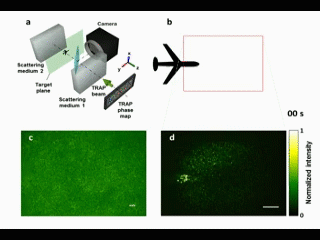Improving imaging of cancerous tissues by reversing time
November 3, 2014

Dynamic focusing onto a moving target inside scattering media (credit: Washington University in St. Louis)
Washington University researchers have developed a novel “time-reversal” technology that allows for better-focused light in tissue, such as muscles and organs,
Current high-resolution optical imaging technology allows researchers to see about 1 millimeter deep into the body. Beyond that, the light scatters and obscures the features, which is why we can’t see bones or tissue in the hand with a flashlight. To overcome this, Wang and his lab developed photoacoustic imaging, which combines light with acoustic waves, or sound, to form a sharper image even several centimeters into the skin.
In new research published Nov. 2 in Nature Photonics Advance Online Edition, Lihong Wang, PhD, the Gene K. Beare Distinguished Professor of Biomedical Engineering, is now using a new technology called time-reversed adapted-perturbation (TRAP) optical focusing, which sends guiding light into tissue to seek movement.
How it works
The light that has traversed stationary tissue appears different than light that has moved through something moving, such as blood. By taking two successive images, they can subtract the light through stationary tissue, retaining only the scattered light due to motion. Then, they send that light back to its original source via a process called time-reversal so that it becomes focused.
In 2011, Wang’s lab was the first to use ultrasound focusing to provide a virtual, non-invasive internal guide star that allowed them to focus on anything moving in tissue. But TRAP focusing is much more efficient in tracking moving targets, Wang says. TRAP focusing can enhance and contrast by redistributing and concentrating light on the targets, allowing for images to be taken from greater depths.
Wang, an internationally renowned expert in photoacoustic imaging, is or has been principal investigator on 37 research grants with a cumulative budget of $47 million. Most recently, he received a three-year, $2.7 million BRAIN Initiative Award from the National Institutes of Health and the 2015 Britton Chance Biomedical Optics Award from SPIE for his pioneering technical contributions and visionary leadership in the development and application of photoacoustic tomography, photoacoustic microscopy and photon transport modeling. He also has received the NIH FIRST and the NIH Director’s Pioneer awards as well as the National Science Foundation CAREER Award.
Abstract of Time-reversed adapted-perturbation (TRAP) optical focusing onto dynamic objects inside scattering media
The ability to steer and focus light inside scattering media has long been sought for a multitude of applications. At present, the only feasible strategy to form optical foci inside scattering media is to guide photons by using either implanted1 or virtual2, 3, 4 guide stars, which can be inconvenient and limits the potential applications. Here we report a scheme for focusing light inside scattering media by employing intrinsic dynamics as guide stars. By adaptively time-reversing the perturbed component of the scattered light, we show that it is possible to focus light to the origin of the perturbation. Using this approach, we demonstrate non-invasive dynamic light focusing onto moving targets and imaging of a time-variant object obscured by highly scattering media. Anticipated applications include imaging and photoablation of angiogenic vessels in tumours, as well as other biomedical uses.